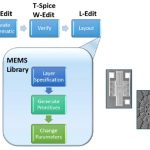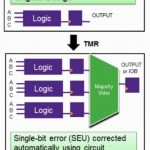Google’s Project Tango is a prime example of a sophisticated application pushing the boundaries of what is possible within the power envelope of a mobile device. Its objective is to combine 3D motion tracking with depth sensing to understand how a device is moving and gauge its surroundings precisely.… Read More
Author: Don Dingee
Mass customization coming to MEMS?
With the industry abuzz about the Apple purchase of a Maxim Integrated fab as a potential R&D facility for MEMS design, it begs the question: is creating a MEMS device that easy?
MEMS technology is approaching the same fork in the road where digital design encountered LSI four decades earlier. … Read More
3 flavors of TMR for FPGA protection
Back in the microprocessor stone age, government procurement agencies fell in love with the idea of radiation hardened parts that might survive catastrophic events. In those days, before rad-hard versions of PowerPC and SPARC arrived, there were few choices for processors in defense and space programs.
One of the first rad-hard… Read More
5 ways FPGA-based prototyping shrinks design time
Engineers are trained to think linearly, along the lines of we started here, then we did this, and that, and this other stuff, and here is where we ended up. If you’ve ever presented in an internal review meeting, sales conference, or a TED-like event, you know that is a dangerous strategy in winning friends and influencing people.… Read More
Mentor takes IoT devices to cloud and back
Walking into the Mentor Graphics booth at ARM TechCon, I was greeted by my friends Warren Kurisu and Shay Benchorin. It was good to see them both again. They were poised in front of a table with a Samsung tablet and a small Wi-Fi-ish box, next to a large Samsung printer. The demonstration was similar to a lobby check-in process, where… Read More
Finding under- and over-designed NoC links
When it comes to predicting SoC performance in the early stages of development, most designers rely on simulation. For network-on-chip (NoC) design, two important factors suggest that simulation by itself may no longer be sufficient in delivering an optimized design.
The first factor is use cases. I think I’ve told the story … Read More
Vector DSP IP charts course for IoT/M2M
For some time, we’ve been talking about ideas for IoT-specific chips, evolved from garden-variety MCUs or mobile SoCs. I sat in on a fascinating talk from an MCU vendor at ARM TechCon 2015 regarding multi-protocol radio silicon, and a question kept coming from the audience: what about software-defined modems? The vague response… Read More
More than just mobile phones for Mali
ARM TechCon 2015 was another tour de force for ARM and its ecosystem. Besides some of the developments in mobile, IoT, and security (more coming soon in the Epilogue of “Mobile Unleashed”), there were two topics that I found very educational and will cover in blogs this week. One was how the Mali family is powering more than just mobile… Read More
64-bit for the masses with Cortex-A35
It has been four years since the announcement of the ARMv8 instruction set, three years since the launch of the ARM Cortex-A57 and Cortex-A53 cores, and two years since the Apple A7 with its “Cyclone” core blew away any misunderstanding of 64-bit as being just for servers.
There is, however, still this idea that 64-bit is only for … Read More
A moment of IoT silence before we disrupt
As I sat down in the SEMI Arizona Chapter breakfast meeting a few weeks ago, a moment of semiconductor history flew right before my eyes before the IoT sessions started.
We were seated in the cafeteria of Freescale Building 94 on Elliot Road in Tempe, a place I’d been many times before, except this time may have been the last. NXP is consolidating… Read More













Jensen Huang Drops Donald Trump Truth Bomb on Joe Rogan Podcast